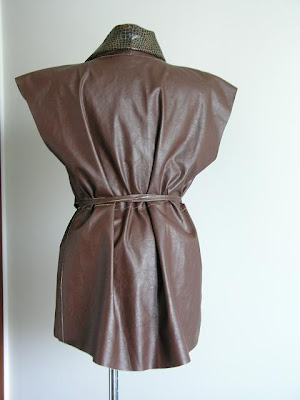 EN: Before proceeding with Paco’s jacket construction I really want to thank you all for the understanding and the support. This is a three day weekend for me (Monday is a holiday here) so I’m making the most of it, even more because the weather is stormy outside so what better weather for staying at home and sew, right?
EN: Before proceeding with Paco’s jacket construction I really want to thank you all for the understanding and the support. This is a three day weekend for me (Monday is a holiday here) so I’m making the most of it, even more because the weather is stormy outside so what better weather for staying at home and sew, right?When I moved to the front reinforcement panel I noticed that it would be easier to set it in place with no seam allowance on the edge, so I removed it:
---
PT: Antes de mais agradeço a vossa compreensão e apoio. Este fim-de-semana tem mais um dia, pois 2ª-feira é feriado, e espero torná-lo num fim-de-semana muito produtivo, para compensar a falta de tempo durante a semana de trabalho. Ainda para mais, está um tempinho mesmo convidativo para ficar em casa (chuva e muito vento). Vamos então continuar com a jaqueta do Paco:
Prosseguindo com a aplicação do reforço na frente, reparei que para o aplicar mais facilmente teria de deduzir a margem de costura que tinha deixado na orla da frente:

6 – Catch stitching the front reinforcement to the jacket’s front
I did it all by hand, being very careful not to pierce the pleather's right surface. The right reinforcement panel should have an opening where the buttonhole stands, and it should also be catch stitched to tack it down to the edge of the buttonhole.
6 – Aplicação do reforço, cosendo em redor com pontos cruzados à mão
Neste ponto é preciso cuidado para a agulha não perfurar a napa até ao direito. Deve-se também fazer uma abertura na parte direita da frente, para acomodar a casa de botão metida na costura. Também cosi com pequenos pontos cruzados em redor desta abertura.


EN: When the reinforcement piece was already attached I noticed that the lower front edge could use a little more support for stability, so I fused beta tape along the edge. The clever thing to do would be to fuse the beta tapes to the reinforcement before applying it to the front. Instead of the fusible tape I could also have used regular cotton tape, machine or handstitched to the edge of the reinforcement panel.
---
PT: Depois de aplicar o reforço, reparei que a orla da frente em tecido podia ser adicionalmente reforçada com fita beta (fita de entretela de colar a ferro). Se voltasse a fazer esta jaqueta, colava primeiro a fita ao reforço e só depois aplicava o reforço, mas como não me lembrei, apliquei a fita no fim. Também podem usar fita de algodão normal e cose-la ao reforço à máquina.

7 – Stitching the shoulder/upper sleeve seam
I pressed the seam allowances to the back and topstitched, ending at the sleeve’s hem edge:
7 – Fechar a costura dos ombros e costura superior da manga
Depois de coser assentei as margens na direcção das costas e cosi um pesponto:

EN: Notice how I treated the seam allowances to reduce bulk:
---
PT: Na bainha da manga não é preciso pespontar. Reparem no tratamento dos valores de costura, para reduzir o volume da bainha depois de pronta:


8 – Sides and lower sleeve seams
This seam was stitched as a single step and the seam allowances were pressed open (don’t forget to leave the pocket openings unstitched and then stitched with a lower tension/long stitch setting, just to be able to press seams open along the side and construct the in-seam pockets later). At the lower armhole corner I also stitched some cotton tape to provide additional reinforcement to this area:
8 – Costura dos lados e costura inferior das mangas
Esta costura é cosida de uma só vez e os valores de costura assentes abertos (não se esqueçam de deixar a abertura para os bolsos nas laterais, que pode ser fechada com pontos soltos nesta altura). No canto de união da cava, onde temos a junção da napa com o tecido, usei um pouco de fita de algodão como reforço adicional:

EN: Here’s the seam treatment on the sleeve hem:
---
PT: Vejam o tratamento na área da bainha das mangas:


EN: The curved seam right bellow the armhole corner should be clipped before pressing the seam open:
---
PT: A zona curva da costura lateral (em tecido) deve levar uns golpes para assentar melhor com os valores de costura espalmados:

EN: Here’s the right side view of the armhole lower corner:
---
PT: O canto da cava do lado direito ficou assim:


9 – Press all the hem allowances to the wrong side of the garment
10 – In-seam pockets
At this point I direct you to Paco’s tutorial so no further explaining and illustration is needed; here’s the pocket bags with the facings that I’ll be using:
9 – Assentar a ferro todas as bainhas para dentro
10 – Confecção dos bolsos metidos nas costuras
Aqui remeto-vos para o excelente tutorial do Paco. Na foto podem ver os sacos dos bolsos já com a vista de tecido aplicada.

EN: Next step is bagging the lining, the subject to next post (it’s a lot easier to do than to explain/illustrate, believe me!).
---
PT: Depois dos bolsos, passaremos para o forro aplicado totalmente à máquina (muito fácil de fazer mas difícil de explicar e ilustrar, acreditem!), um assunto para o próximo artigo. Até breve!


































